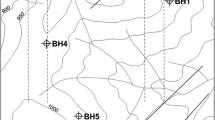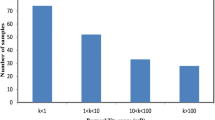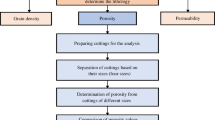Abstract
This paper intends to contribute to a better understanding of the Statfjord Formation in the North Sea, based on the study of some lithotypes of the Lourinhã Formation analog. A mineralogical and physical characterization was performed. A Fast RILEM water absorption test is herein proposed to carry out on sandstone drilled cuttings and cores that were cut into specimens, to assess permeability-related parameters. Results in a faster way on rocks with porosity values higher than 15% are given by this test in comparison to traditional laboratory methods. A correlation factor of 4–5 was obtained between permeability (mD) and water absorption coefficient (lb/ft2√h).
Access provided by Autonomous University of Puebla. Download conference paper PDF
Similar content being viewed by others
Keywords
1 Introduction
Lourinhã Formation has fluvial successions similar to the Statfjord Formation in North Sea. Keogh et al. (2014) cited in [1] assigned these to Late Triassic and Lower Jurassic. In order to characterize the Statfjord Formation and contribute with data to the reservoir modelling of the Norwegian North Sea’s Tampen fields, this Portuguese Formation in the western Region of Portugal was studied and field data were obtained [1].
Sandstone strata are the main rocks of Lourinhã Formation that has a thickness up to 900 m [1]. Stratigraphy and tectonics studies of the Lusitanian basin and Lourinhã Formation, assigned to Early Tithonian and Late Kimmeridgian age, were given by Martinius and Gowland (2011) and Taylor et al. (2014) cited in [1].
In order to contribute to a deeper understanding of the North Sea’s Statfjord Formation, an experimental work was carried out [1]. Mineralogical and physical properties data were obtained from samples collected from Lourinhã Formation analog. Also, a fast RILEM test was carried out on sandstone specimens and could also be performed on drilled cuttings and cores that were cut into specimens, to evaluate permeability-related parameters. Permeability and porosity of reservoir rocks are included in the most important physical properties used worldwide on reservoir characterization and modelling [1]. Fast methodologies for determining permeability-related parameters on drilled cuttings and cores from wells are very helpful tools which allow the correlation to other properties obtained from well logs, e.g. density, gamma ray, neutron, nuclear magnetic resonance, spontaneous potential, electrical resistivity and sonic [2].
Since samples were cleaned off oil using Soxhlet Extraction methodology [3] and were dried, this test gives results in a faster way on rocks with higher open porosity values in comparison to traditional laboratory methods. Moreover, a correlation between permeability and water permeability-related test data can be established in this experimental work herein presented.
2 Experimental Program
According to EN12407 recommendations [4], samples were collected from sandstone outcrops and thin section observations were performed under petrographic polarizing microscope. Following the point counting method, modal analysis was performed.
Sandstone blocks of M variety were cut in cubic and prismatic samples with circa 5 cm (2 in.)-long on cross section and a length of about 10 cm (4 in.) on the former samples.
According to RILEM [5] and EN1936 [6], porosity and density of sandstone samples were determined based on hydrostatic weighing and Archimedes principle, applied in these physical tests which were carried out.
AutoPore IV9500 of Micromeritics Instrument Corporation was used and pore size distribution for M variety sandstone was obtained. The pores radii’s percentage lower than 7.5 μm was considered as microporosity [7]. The Katz and Thompson [8] method allowed to infer permeability from Mercury Intrusion Porosimetry.
The test of water absorption under low pressure (pipe method) was carried out on cubic and prismatic sandstone samples according to RILEM [5] procedure. Figure 1 shows the Karsten tube.
This device has a total measured height of water of 0.322 ft and a volume of 1.41 × 10−4 ft3. Water fills this vertical tube from the upper opening of the tube up to the graduation ‘‘0’’. The Karsten tube is sealed on sample surface by a not deleterious and removable putty. The results are exhibited on graphs of water absorption, being:
Δm is the variation of mass of water (lb) and S2 is the area of absorption (ft2). The graphs show these results in function of square root of time given in hours or seconds. The coefficient of water absorption of the test curve is given by the slope of the linear part.
3 Experimental Result
Four varieties of sandstones [1] were found on outcrops and were classified according to the classification of Folk [9] as lithic arkose containing carbonate cement. These four varieties were named A, B, C and M and are considered the lithotypes A + B and C + M. The lithotype A + B has around 34–40% carbonates and the lithotype C + M has circa 20–25% carbonates. The former lithotype has 30–32% quartz and the latter lithotype has 40–51% quartz. All these lithotypes contain circa 4–6% of minerals of mica.
Mean values of porosity of the samples of these two lithotypes range between 3.6% on A variety to 12.7% on C variety and 18.5% on M variety. The bulk density of M variety is about 446.5 lb/ft3. The percentage of microporosity of M variety is about 75% and the median pore radius is circa 3.6 µm (obtained at 50% of the total amount of volume of mercury injection). Katz and Thompson method [8] was applied and the inferred permeability values ranged from 20 to 30 mD.
Figure 2 and Table 1 show the results of the absorption of water under low pressure (Karsten tube) tests on M sandstone variety. The average value obtained is about 5.3 lb/ft2√h with a coefficient of variation smaller than 10%.
4 Analysis of Experimental Results
These M variety samples collected in Lourinhã Formation, classified as lithic arkose with carbonate cement, with an average porosity ± standard deviation of 18.5 ± 0.4% obtained on 140 specimens, revealed permeability inferred values of 20–30 mD. The average water absorption coefficient under low pressure is about 5.3 lb/ft2√h.
Ehrenberg and Nadeau [10] reported that siliciclastic world reservoirs with median porosity statistical class of 17.5–22.5%, exhibited average values of permeability of 18 mD. Similar average values to those values mentioned are shown by samples of Sandstone M variety.
Further research should be carried out, but at a glimpse, a correlation between permeability and water absorption coefficient (pipe method) could be established: The permeability (mD) is about 4–5 times higher than the water absorption coefficient (lb/ft2√h) on M variety sandstone.
This test procedure will require only several minutes or even seconds to give results on rocks with open porosity values higher than 15%. Permeability determinations from Mercury Intrusion Porosimetry inferred from Katz and Thompson [8] method was carried out and took at least half a day to be obtained. Air permeability obtained from steady state or transient pulse methods [11] needs much more expensive equipment, and even these tests require similar times in comparison to RILEM method.
5 Conclusions
An experimental study was carried out on M variety sandstone assigned to Lourinhã Formation, an analog of the Statfjord Formation in the North Sea. A mineralogical contribution study and a physical characterization was performed, including a fast RILEM permeability-related test. A correlation between permeability (mD) and water absorption coefficient (lb/ft2√h) was obtained at a factor of about 4–5. However, further research should be carried out on other siliciclastic and carbonate Oil & Gas reservoirs.
References
Ludovico-Marques, M., Chastre, C.: Effect of artificial accelerated salt weathering on physical and mechanical behaviour of sandstone samples from surface reservoirs. In: Hamdy Makhlouf, A.S., Aliofkhazraei, M. (eds.) Handbook of Materials Failure Analysis With Case Studies from the Oil and Gas Industry, pp. 215–233. Elsevier, New York City (2016)
Nnaemeka, E.: Petroleum Reservoir Engineering Practice, p. 770. Prentice Hall, Upper Saddle River (2011)
Jobe, T.D.: Non-traditional techniques for microporosity evaluation in a low-permeability carbonate reservoir from a giant reservoir offshore Abu Dhabi, U.A.E. In: AAPG 2013 Annual Convention and Exhibition (2013)
EN 12407: Natural stone test methods—petrographic examination. Eur stand2000 (2000)
RILEM: Recommended tests to measure the deterioration of stone and to assess the effectiveness of treatment methods. Mater Constr., Bourdais-Dunoud 13(75), 175–253 (1980)
EN 1936: Natural stone test method-determination of real density and apparent density, and of total and open porosity. Eur. Stand. (1999)
Pellerin, F.: La porosimetrie au mercure appliquee a l´ etude geotechnique des sols et des roches. Bull Liais Lab Ponts Chausse´s 106:105–116 (1980)
Katz, A., Thompson, A.: Quantitative prediction of permeability in porous rock. Phys. Rev. Online Arch. B34, 8179–8181 (1986)
Folk, R.: Petrology of Sedimentary Rocks. Hemphill Publishing, Austin, TX (1974)
Ehrenberg, S., Nadeau, P.: Sandstone versus carbonate petroleum reservoirs: a global perspective on porosity-depth and porosity-permeability relationships. AAPG Bull. 8(4), 435–445 (2005)
Filomena, C.M., Hornung, J., Stollhofen, H.: Assessing accuracy of gas-driven permeability measurements: a comparative study of diverse Hassler-cell and probe permeameter devices. Solid Earth 5(1), 1–11 (2014)
Author information
Authors and Affiliations
Corresponding author
Editor information
Editors and Affiliations
Rights and permissions
Copyright information
© 2019 Springer Nature Switzerland AG
About this paper
Cite this paper
Ludovico-Marques, M. (2019). A Fast and Less Expensive Test to Determine Permeability-Related Parameters on Well’s Drilled Cuttings. In: Banerjee, S., Barati, R., Patil, S. (eds) Advances in Petroleum Engineering and Petroleum Geochemistry. CAJG 2018. Advances in Science, Technology & Innovation. Springer, Cham. https://doi.org/10.1007/978-3-030-01578-7_3
Download citation
DOI: https://doi.org/10.1007/978-3-030-01578-7_3
Published:
Publisher Name: Springer, Cham
Print ISBN: 978-3-030-01577-0
Online ISBN: 978-3-030-01578-7
eBook Packages: Earth and Environmental ScienceEarth and Environmental Science (R0)






